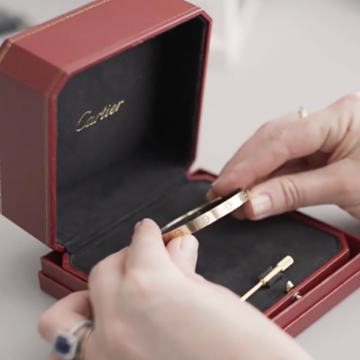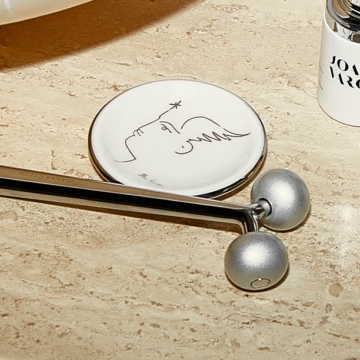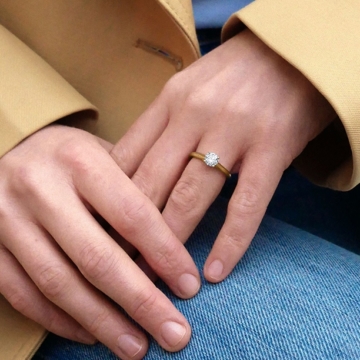
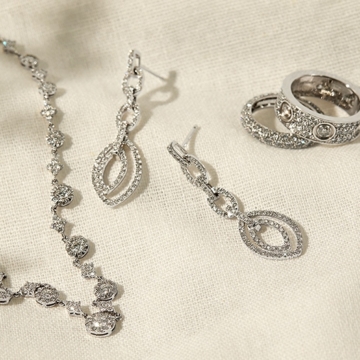
How To Clean Jewelry: Gold, Your Diamond Ring & More
Jewelry is so often a personal story. The diamond ring that was passed down or given to you by someone special in your life. The gold necklace you wear like a talisman that tells who you are without saying a word. The gemstones that reflect the colors you’re most drawn to, like facets of your personality. The classic investment piece by Cartier or Tiffany & Co. you saved up to buy with your own hard-earned cash.
Experts At Your Service – How To Clean Jewelry At Home from The RealReal on Vimeo.
But whether you wear certain pieces of jewelry daily or treat them as rare heirlooms or special occasion investments that mostly stay safely tucked away in your jewelry box, they have one thing in common: they could all use some cleaning and care to keep them at their sparkling best. But can you safely clean your jewelry at home? There are so many questions, from which cleaning solutions to use to how often to clean to knowing how to avoid damage. Jewelry is special, some of it irreplaceable, and cleaning it is something you definitely want expert advice on. That’s exactly what we’ve put together here. We turned to Kara Simone, Associate Fine Jewelry & Watch Valuation Manager at The RealReal for a guide on how to clean your jewelry at home and safely restore pieces to their original shine. Watch her explain and read on for tips on cleaning everything from a diamond ring to gold jewelry, plus special strategies for gemstones.
First Things First: Prepping To Clean Jewelry
Before you get started there are few important things to keep in mind…
Know what you’re dealing with: “I would avoid going into the cleaning process not armed with information on what type of pieces you have,” cautions Simone. “Make sure you know what type of stone and metal you have, and if you’re unsure, talk to a jeweler first. For example, gold jewelry can handle the cleaning solutions we’ll mention in this guide, but if you have a piece that might be gold-plated, it will not hold up as well and the plating could be stripped. It is also a good practice to have antique or estate pieces professionally cleaned to preserve the finish and look of the piece.”
Know when to clean: “Diamond pieces that are worn every day can be cleaned once a week, or even more often if you prefer. This will keep the piece sparkling by regularly removing build-up and oils. Pieces that are not worn as often can be cleaned as needed — for example, when you see a silver piece start to tarnish.”
Know what to avoid: “Each piece requires care and special consideration, but in general you definitely want to avoid using any cleaning techniques that can be harsh or damaging,” says Simone. “This can mean many things depending on the materials you are dealing with, but generally you want to avoid chemicals like bleach and household cleaners, anything abrasive and anything acidic like vinegar.”
A Simple Solution
Our top recommendation for cleaning your jewelry is our own The RealReal natural cleaner. It’s plant-derived, hypoallergenic, and water soluble, and is specifically formulated to work on a range of jewelry made of various metals and stones (the one caveat is that, like the other cleaner we’ll mention, it shouldn’t be used on porous stones). It even includes a jewelry basket (so you don’t lose your piece in the sink, yikes!) and brush. But, if you need to clean your piece now with what you have on hand, there is an alternative.
How To Make Homemade Jewelry Cleaner: “Making an at-home jewelry cleaning solution is as easy as mixing warm water with a mild dish soap,” Simone explains. “Dish soap eliminates grease, which makes it a great choice.” Simply add a few drops of soap to warm water in a small bowl. Make sure the water is not too hot or too cold. “You can use this to soak and then clean jewelry that can withstand it (such as platinum, diamond and un-plated pieces), and to wipe down pieces that should not be soaked. There are other solutions that can be used for stones and metals that are more resilient, but this solution is the most widely and highly recommended (including by the GIA!) as it is mild and will not damage your jewelry.”
A Diamond Is Meant To Shine
How To Clean A Diamond: “Diamonds are known for attracting grease which can dull their sparkle,” notes Simone. Kind of a bummer considering a diamond ring is often a piece you wear every. single. day. (especially an engagement ring). Thankfully, the fix is easy. “The solution above and a toothbrush can work wonders for the appearance of your diamond. Make sure to use a new, soft-bristled toothbrush since it will be the most gentle on your diamond.”
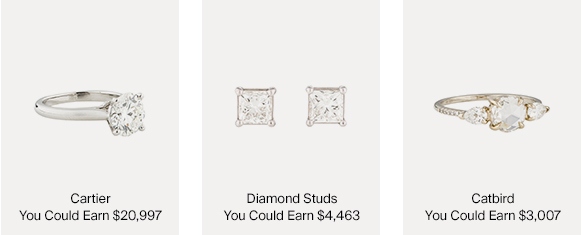 Cartier Platinum Diamond 1895 Engagement Ring; Diamond Stud Earrings; Catbird 14K Diamond Ring
Cartier Platinum Diamond 1895 Engagement Ring; Diamond Stud Earrings; Catbird 14K Diamond Ring
First, let the diamond soak to loosen any residue. The soak time can vary based on how much build-up there is and the style of setting. You can soak for as little as a few minutes or even overnight, checking on the piece intermittently. Next, scrub the piece with soapy water and the toothbrush. Once that’s done, “ just make sure to rinse and dry the piece afterwards,” says Simone.
The Gold (& Silver) Standard
How To Clean Gold & Silver: These pieces are often timeless classics that tend to get a lot of wear. Here’s how to shine yours up. Similarly to diamonds, “Gold can be soaked in warm water with a few drops of dish soap for a few minutes or as long as overnight depending on how much residue is on the piece,” explains Simone. “A Q-Tip with the dish soap and water solution can be very useful to remove tarnish from gold pieces as well.”
 Tiffany & Co. 18K Oversized Ball Necklace; Cartier LOVE Bracelet; 14K Chunky Curb Link Bracelet
Tiffany & Co. 18K Oversized Ball Necklace; Cartier LOVE Bracelet; 14K Chunky Curb Link Bracelet
For silver, turn to a handy tool that works wonders on tarnish. “A polishing cloth is a mildly abrasive cloth that can be rubbed on the areas of tarnish on a piece of jewelry,” notes Simone. Don’t have one on hand? Not to worry — there are a few other at-home cleaning tricks you can try. The first is the same go-to solution of dish soap and warm water, which can be applied to a cloth. “Use the cloth to remove areas of tarnish on the piece,” says Simone. “You can also use three parts baking soda to one part water, and rub the mixture on the piece with a cloth on areas that are tarnished. Always make sure to rinse and dry the piece thoroughly.”
Rare Gems
How To Clean Gemstones: Jewelry designs made from colorful stones make for unique, stunning statement pieces, but keep in mind that they can also require special care. “As a general rule diamonds, rubies and sapphires are very durable and can hold up to various cleaning techniques,” Simone says. “But most other stones have guidelines that should be followed so you don’t damage the piece.” Pearls and other organic stones, such as coral, are porous and can be more easily damaged. “Avoid soaking these in water,” warns Simone. The same applies to opals, which can become waterlogged, muting the play of color naturally in the stone.
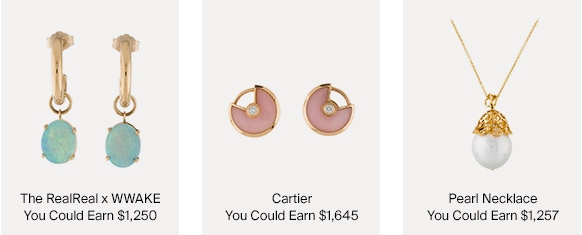 The RealReal x WWAKE 14K Opal Earrings; Cartier Amulette De Cartier Earrings; 18K Pearl & Diamond Pendant Necklace
The RealReal x WWAKE 14K Opal Earrings; Cartier Amulette De Cartier Earrings; 18K Pearl & Diamond Pendant Necklace
“You also want to avoid any acidic, harsh or abrasive cleaning solutions. This can include, but isn’t limited to, household cleaners, baking soda and vinegar.” What you can use is (you guessed it!) a solution of warm water and dish soap, not to soak the pieces, but on a cloth to gently wipe them down. Soft materials like pearl, opal, coral, amber and jade can also be easily scratched, so avoid using anything abrasive. What to do if you have an even rarer stone not mentioned here? “ I recommend turning to the GIA (The Gemological Institute of America),” says Simone. “They offer in-depth care and cleaning guides to cover each gem you may come across. You can go to GIA.edu and search ‘care and cleaning’ or search by stone.”
Wear, Care, Consign
How To Care For Jewelry: Cleaning and caring for your jewelry will not only keep it looking its best, it will lengthen the life of your pieces, and earn you more should you decide to sell them. In addition to cleaning your jewelry, Simone advises taking a few precautions to care for it as well. “Definitely take off jewelry when showering, swimming, or doing activities like dishes and working out,” she notes, “and avoid bar soaps, perfume and lotions, as they can cause build up and be difficult to clean.” Jewelry should be stored in a safe, dry place, preferably with each piece in a soft cloth bag so they don’t come in contact with each other, which can cause scratching and other damage.
Thinking about selling? A well-cared for piece will pay off. Jewelry that’s in better condition not only sells for more, it sells faster, as The RealReal Fine Jewelry Merchandise Manager Lindsey Taft explains. “Items in excellent and very good condition sell 20% faster on The RealReal than items in good condition,” she says, with 66% of items in excellent and very good condition selling in the first 30 days versus 55% of items in good condition. They’ll earn you more, too. “The average resale value for items in pristine condition is over $1k versus $784 for items in good condition,” she notes. Treat your pieces like the treasure they are, and you (or someone else) can enjoy maximum shine for many years to come.
All polished up and ready to sell? Learn more about consigning here.


